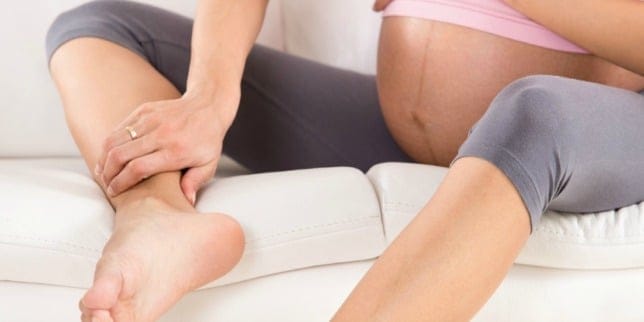Common Leg Problems During Pregnancy

With all the extra weight, it's no wonder your legs ache.
While pregnancy is a time to celebrate the baby to come, our bodies go through several unwanted physical changes that we’d rather avoid. Nausea, heartburn, morning sickness, fatigue, and back pain are all frequent complaints during pregnancy that we all know very well. But what about our legs? With the extra weight that you have to carry around nonstop, leg problems are actually just as common, particularly during the last trimester. Though these ailments will likely go away after you deliver, you can do a few things to alleviate any discomfort you may be experiencing.
Here are 5 of the most common pregnancy leg problems, and what you can do to make it.
1. Swelling. During the third trimester, the hormone relaxin is released. This hormone doesn’t just relaxes your pelvic ligaments for childbirth. It also lengthen foot ligaments and make you retain more water. During pregnancy, your blood vessels may also be smaller, which can make it hard for your body to let the extra fluid flow through. So what’s the end result? Swelling in your legs and ankles. In fact, many women develop “cankles” — a swelling of the ankle that is so large, you can’t distinguish the shape of the ankles anymore.
The best way to manage swelling is to keep your feet elevated as often as possible especially towards the end of the day. In addition, because of the added weight, your center of gravity will shift so it is important to wear shoes that help support and balance you. A diet lower in salt could also help reduce water retention and, as a result, swelling.
2. Knee Pain. As you progress through the pregnancy, your knees will have to sustain extra weight, which can be really painful as it adds pressure on your joints (especially the lower extremities). Hormonal changes during pregnancy also contribute to knee pain. When the hormone relaxin is released, it also causes the joints around the knees to loosen. This could cause instability and your kneecap may feel less stable.
To alleviate knee pain, keep your legs elevated as much as possible and avoid standing for long stretches at a time. Consider wearing comfortable shoes and engaging in low-impact exercise.
3. Calf Muscle Cramps (a.k.a. Charley Horses). Leg cramps can appear when you least expect it — for example, in the middle of the night, when your legs are tired. These painful muscle contractions usually occur in the calf. Leg cramps, experts say, could be a result of a calcium deficiency or excess phosphorous (found in sodas). For women, charley horses or leg cramps have been associated with dehydration (lack of potassium).
A daily intake of potassium rich sources such as bananas would thus be a good way to help prevent cramping. A short walk or pacing around your home during evening hours can increase circulation in your lower body, which can also keep cramping at bay. If you find yourself having to jump out of bed because the cramping and leg pain is unbearable, try to walk it out. You can also keep a heat pack ready to help the soreness that you may experience after cramping.
4. Sciatica Pain. Sciatica refers to pain shooting down your back or radiating down your leg. It’s caused by the compression of the sciatic nerve, a nerve that runs from the lower back down the back of each leg. Most women experience it late in their second or third trimester because the growing fetus adds pressure on the nerve.
Sciatica pain comes and goes. If you are desperate for some relief, try prenatal massages, gentle leg stretches, exercises like walking or yoga, and Tylenol.
5. Varicose Veins. According to dermatologist Anthony Rossi, “Women are particularly susceptible to varicose problem because vein walls and valves periodically become more dilated when progesterone increases. During pregnancy, circulating hormonal factors h increase the distensibility of vein walls and the veins have to deal with more circulating blood volume which causes more pressure on the veins.” More specifically, pregnant women may experience varicose veins if they gain too much weight, stand for too long, which puts pressure on the lower extremities, or if your mother experienced them as well (yes, they are hereditary). They can cause discomfort and overall body fatigue.
Increasing circulation could help relieve discomfort and even prevent varicose veins in the first place. Try taking a walk every day, engaging in low-impact exercises such as swimming or using compression socks.
Pregnancy has its share of lower body ailments. But the good news is, most of them usually go away after pregnancy. If you happen to experience them, try to relax and consider the relief methods we’ve suggested. Do you have any tips on relieving leg pain during pregnancy?
Image via Prime Compression.
































